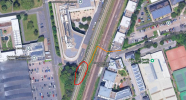markymark2000
Established Member
Could it be that the jobs in the area are so well paid that people can stomach the costs?Public car parks are already scarily expensive. For example, Grafton East car park:
Grafton East car park
Grafton East car park is located at the Grafton shopping centre, about a 15-minute walk from the city centre. It’s the nearest car park to the Crown Court and Anglia Ruskin University.www.cambridge.gov.uk
One thing that would probably help massively would be to make buses more convenient and start focussing not on making cars less attractive, but buses more attractive. Why does everything have to be a race to the bottom and forcing people to use certain transport modes rather than trying to make things the best that they can be? Racing to the bottom only infuriates drivers.
Purely for example, Something that I have noticed, Luton Busway has 17 buses per hour (not including those which only do the small bit and come off at Challney). Cambridge Busway between the Station and Addenbrookes, despite the rather large flows, has only 8 buses per hour. The other around 19 buses per hour, plod along Hills Road getting seemingly, increasingly delayed. Granted not all buses would/should move to the busway as it's probably important the keep a route running along Hills Road and it wouldn't be worth the costs for irregular services (mostly those operated by A2B) but a number of other services could move.
There are only 2 reasons really why any bus should use Hills Road over the busway (other than . That being the bus needs to access the education establishments on Hills Road, or the route is operated by double deckers.
A solution to the former, is to install an intermediate busway stop at the top end of Shaftesbury Road and build a pedestrian bridge linking over the train tracks to this new stop? See below photo for an idea of stop placement (red marks the stop, orange is the rough layout of a bridge) This stop would be within 5 minutes walk of the Sixth Form college and Homerton university buildings. This would enable the U2 to transfer to the busway and perhaps also Whippets X2/X3 services.
The solution to the latter is easy to suggest but perhaps less easy in terms of funds and politics. If Hills Road bridge was rebuilt so deckers could be accommodated on the southern busway, that would change things drastically. As I say though, not sure if this is likely to be possible.
Essentially, make the buses easier to access and stop the buses being caught in such congestion (which is what brings motorists to say such things as 'slow and unreliable'). Got to be better shorter term and also politically to make buses better so people choose to use buses, rather than restricting motorists and forcing them to use buses which will only stir up hatred.

